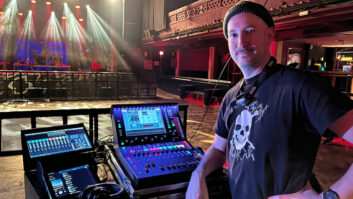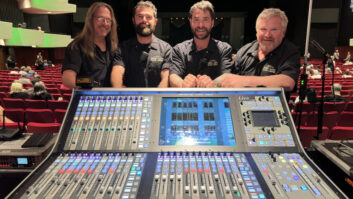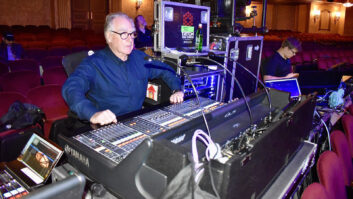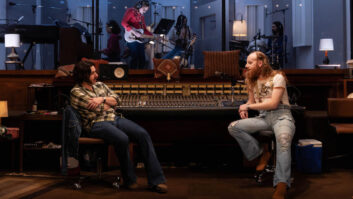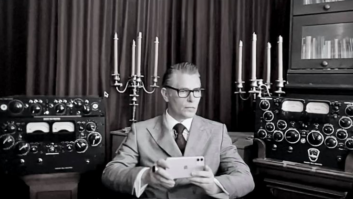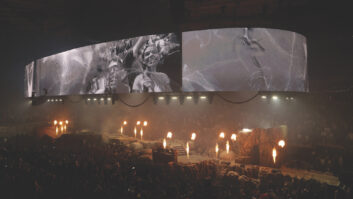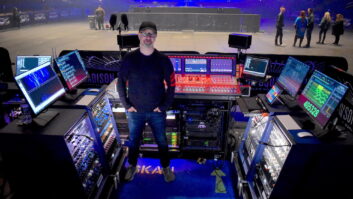The riotously funny and critically acclaimed The Chris Rock Show, which explored the boundaries of outrageous, politically tinged humor for four years on HBO, began each night with a barbed stand-up routine, then brought out a guest, then featured a single musical number, usually with amped-up energy. It’s not easy to translate the raucous feel of a live audience to the small screen at home, but Chris Rock did it every Friday night, and the show’s commitment to on-air and in-studio audio quality played a large role. In fact, a tour of the production (made during the last days of the final season, which ended just after Thanksgiving — after four Emmy nominations, the show was canceled), showed just how TV shows can incorporate live sound systems, without compromise.
The Chris Rock Show used what was essentially a small touring package for the in-studio musical sound reinforcement, and there was a definite method to the seemingly audio overkill. Star and executive producer Rock wanted the tapings to be high energy and fun for the studio audience. “The Chris Rock Show was the closest thing [I’ve done in television] to a real, live stage show,” says FOH engineer Paul Cohen. “Grandmaster Flash [the show’s musical director and founder of the seminal 1970s-1980s-era rap group Grandmaster Flash and The Furious Five] would warm the crowd up,” spinning and scratching records on his two turntables from his mid-audience perch. “Then the warm-up MC would segue that energy, and [the tape would roll and] Chris would come out, and we’d tape straight through as if the show was live.”
“Chris liked to keep the energy level high and going straight through,” adds The Chris Rock Show‘s young, energetic and enthusiastic mixer Charlie “C.J.” Jones. The show was indeed conducted as if it was going out on the coaxial live; short live or pre-taped bridge comedy segments allowed for a few minutes of musical soundchecking, so the half-hour show could be taped straight through in that exact amount of time. “We rarely did the musical numbers a second time,” Jones explains, again noting the star’s interest in maintaining an energetic live feel. “So it was imperative to get the music mix right the first time.”
Getting it right from the start was crucial, because there was no multitrack recording of the music and therefore no audio post-production (except to fix occasional glitches). “With the show’s reputation for audio quality, yes, some acts and their managers were surprised to learn there was no multitracking or post,” acknowledges Jones. Also, multitracking was eschewed for the practical fact that the show taped at 6:30 on Friday evenings and aired at midnight, leaving precious little time for retakes or tweaking.
WHISPER AND SHOUT
We’ll get back to the music in a minute. The show is about Chris Rock, and the biggest challenge for Jones came in dealing with the wide dynamic range of the star’s voice. “Chris Rock’s voice, in musical terms, ranges from pianissimo to fortissimo,” Jones explains, “and I wanted to capture that dynamic range so his voice would be right in the viewer’s face; I wanted the viewer at home to feel like they were in the studio audience. So I needed to get the presence right without overmodulating.”
All show talent used RF lavaliers. Typically, the level on the body pack of a Sennheiser wireless lav unit is set at three, Jones explains. However, with that setting Rock was “overmodulating like crazy. We went to two, then to one and we lost the presence at that lowest setting and could also hear the companders pumping. So we ended up back at two, which gave us just the right balance of presence and signal-to-noise without distortion.”
The star’s mic was compressed with the inboard compression unit of the (custom-made for CBS) angled Neve 7056 board, on which Jones mixed the nonmusical show elements, and from which the final mix emanated. For the star’s mic, Jones used a 3:1 compression ratio with an average gain reduction of six to eight dB with the threshold on the limiter at plus-eight.
(The Chris Rock Show taped its final season at CBS’s huge production facility on West 57th Street in Manhattan, in the largest studio there. Jones notes that the room hosted the early days of The Ed Sullivan Show before that long-running variety hit moved to the Broadway theater that later came to bear Sullivan’s name. David Letterman currently broadcasts from that theater.)
Another challenge in dealing with the star’s voice was the fact that the studio was kept quite cool, around 50 to 60þ, and so there was a lot of ventilation and mechanical noise. “There was a giant AC duct right over Chris’s home base that would blow air right on him. I had to use some tactful EQ to lose it,” Jones says. He notched the noise out at around 80 to 100 Hz, 200 to 300 Hz and again at about 700 Hz to one kHz. He confesses that during many of the interview segments, he had hoped that the guests wouldn’t move around too much, because a small turn of their body in either direction would send a whooshing sound into the guest’s mic from the ventilation system.
An invaluable aid to deal with the noise was a Dolby CAT-430 background noise suppressor, a “sophisticated low highpass filter that sucks out all of the room noise but leaves integrity of the voice,” Jones explains. The Dolby CAT-430 unit was used for all of the show’s lavaliers.
The other talent mics were run through a dbx 160S with a ratio of about 4:1 and a gain reduction of about six dB. The stereo output of the Neve (the show was mixed to stereo only, not to surround) was set at about 1.5:1, with “scant gain reduction so that the peaks would stay at about plus-eight to plus-12,” Jones notes. A Dorrough loudness meter “allowed me to see the peaks so I could run the program as hot as possible without distortion. That, together with the Neve stereo compressor-limiter, kept me from going too far into the red.”
IN THE HOUSE
The main house system, the one that got the audience pumping, was supplied by Clair Bros. and included a 32-input Clair Bros. CBA console and 10 Clair Bros. S-4 speakers (six S-4s and four S-4 subwoofers). “I’ve always wanted to hang S-4s in a TV studio,” says Cohen with a mischievous grin. The main S-4 cabinets were hung in groups of three, stage right and left.
The freedom to make the in-studio sound reinforcement live large was exhilarating for Cohen. “I’ve never had a [TV] client allow me to do what The Chris Rock Show did,” he says. “Having an audience of 250 people and 10 S-4s is vastly out of the norm. I never measured the audio output, but I know it was butt-loud!”
“S-4s are not usually used in TV studios,” explains Greg Hall, business manager for Clair Bros. “Normally, TV uses more of a distributed system rather than something that provides the gee-gosh-wow and bump” of the S-4s, a four-way enclosure with two 18s, four 10s, one horn and a tweeter array. Four S-4s alone are “enough P.A. to do a 1,500 to 2,500-seat theater,” he notes. “The S-4 is our flagship touring box and is used by everyone. It is a very powerful, constant-coverage, full-range cabinet made for vocal intelligibility and good dynamics.”
Additionally, the use of four S-4 subwoofers initially struck Hall as gilding the lily. “The S-4’s two 18-inch speakers usually take care of the lows; there’s normally not a need for subs,” he says. (Hall did not deal directly with the show and so was unfamiliar with the gear list; he noted that Mike Wolf was the Clair Bros. project manager for the show’s gear, which was assembled by FOH man Cohen. Wolf, however, was busy arranging sound reinforcement for a last-minute concert at Camp David to honor President Clinton a week from the election when Mix called. Understandably, Wolf was too busy to comment.)
THE STAGE
“My music console was a Clair Bros. CBA,” Jones says. “It was designed as an FOH board, but the sonic quality is so high that it made a very good on-air console. Engineers would come in and see it and say, ‘Wow, this was my console from when I first went on tour’ and be thrilled to see it. The mic preamps are superb and the EQs are accurate. It is a very open and dynamic-sounding console.” Jones used Genelec 1030A control room monitors and an Auratone Sound Cube as a mono reference.
Jones also used Lexicon PCM 80 and PCM 42 delays and an Eventide Harmonizer to round out his outboard effects. “The Eventide helped me to re-create the sound of the guests’ records or to create an entirely new vibe, as we often did,” he says. “Most of the records [of our musical guests] had the vocals cut quite dry with a lot of chorus effects. The Harmonizer was a great help in re-creating those effects.”
However, Jones occasionally wouldn’t even listen to the musical guest’s record, especially if they were appearing with a backing lineup that differed substantially from the recording. “A lot of the artist’s records were basic hip hop grooves, everything MIDI’d,” he recalls. “But some of these acts, notably Common and Jill Scott, showed up with live drums, bass, horns and Fender Rhodes piano.”
Mic selection was kept simple. Jones had occasionally served as an A2 for industry legend Ed Greene at the Kennedy Center in Washington, D.C., and he learned from the veteran the importance of a simple microphone selection for television work. “Ed Greene always kept things simple in order to facilitate the fast musical turnovers television dictates,” Jones says. “As an audio lover, the temptation is to always search for the best-sounding microphone, but so often it comes back to 57s and 58s and a few condensers. On Chris Rock, we always started with a simple foundation, using the things we know well, because one had to get it right the first time.
“The M88 is my favorite kick mic for television,” he continues. “You want the kick to have the thud, the actual smack, to create the feeling of tempo and pulse. I’d also use an SM91, which also has a good punch and attack that translates well to TV.” Otherwise, he would use the standby SM57 for snare and SM81 for hi-hat, SM98 for toms and SM81 for overheads. Amplifiers nearly always took SM57s, as well; basses were either Countryman DI or SansAmp DI units.
Lead vocal mics were also sent over a Shure RF system. “We had a mic unit that we would use with either an 87 or a 58 capsule, and everyone was happy with them,” Jones relates. No one ever brought their own vocal mic, he says.
Clair Bros.’ low-profile 12AM wedge monitors were mixed on a Yamaha PM3000 console situated directly behind the performance area. Four of the foldback boxes were hung above the stage. In addition to the 10 S-4s, 30 Tannoy I-12 boxes took the nonmusical show sound elements from the other console at the FOH, a 48-input Allen & Heath GL4000.
THE GUESTS, THE AUDIENCE
When Mix visited the taping of one of the final shows, musical guest Jay-Z had to redo his performance of “I Just Want to Love U (Give It 2 Me).” The audio department did not cause the glitch; the members of the group were too often cloaked in shadows as they moved about wildly on the stage. Additionally, the group’s DJ was a bit late in triggering the backing track from his onstage Replay unit. (Jay-Z, who had subbed at the last minute for no-show R. Kelly, didn’t arrive at the studio until moments before the 6:30 taping, so there was not a musical run-through whatsoever, perhaps explaining the miscues.)
The audio preparation for the musical guests was typically somewhat more involved. Normally, Jones’ audio technical manager, Tom Holmes, reviewed the act’s specifications with the band’s representatives early in the week and “knocked their input list down to 30. Most of these acts were touring and so were used to 40-plus ins, but we limited everyone to 30” for the sake of simplicity, Jones explains. Holmes wrote and circulated the downsized input list, and the load-in began early Friday afternoon, leaving about two hours to set up and run through the song twice. “That’s it,” says Jones, regarding musical pre-production.
While there was no musical multitracking, it wasn’t all flying by the seat of the pants. The show was videotaped to Digital Betacam, and the format’s audio tracks were used to isolate the main mics, including Rock, the interview guest, sketch actors, Grandmaster Flash, as well as the stereo bus of the audience, in case something crucial was flubbed.
The audience was intensively covered, using 20 AKG CK-31 mics submixed to a Mackie 24×4 board that sat upright in a dark corner of Jones’ crowded control room (bearing a label scrawled on masking tape reading, “Audience”). Why such intense coverage? “When you’re doing TV comedy, the most important thing is the audience response, and this was especially important in The Chris Rock Show,” Jones says. “You want at least one mic for every 10 to 20 people. This was the first season we used the AKGs; previously, the mics were SM81s, but the art department asked us if there was something smaller, for the sake of appearance, and we just loved the sound of the tiny AKGs.”
For communications, Jones employed a 40-matrix Telex system. Because the producers wanted the stage managers to be on comm even when they were on other floors (where some of the dressing rooms were), antennas were placed much more widely throughout the studio area than is common.
Jones was thrilled with his audio crew, who were “the most top-notch individuals that could’ve come together as a team. They’ve all worked on the Grammys, VH-1 or MTV and were the strongest unit of audio professionals that I’ve ever worked with.” They included: Paul Cohen, FOH; Tom Holmes, audio technical manager; Tony Bandelato, monitor mixer; Dennis Deane, RF A2; Larry Gumpel, communications A2; and alternates Sean Kelly, Skip Tent and John Pernal.
Jones came to The Chris Rock Show from Black Entertainment Television (BET), where he worked on several shows including Teen Summit and BET Tonight with Tavis Smiley. There he was confronted with every conceivable television audio challenge and learned a great deal. But how did the famously BET-bashing Rock respond when he learned his audio mixer was recruited from the cable network that he so humorously derides in nearly every other show? “Chris and I never talked about my coming from BET, but producer Liz Stanton Tormey, who hired me, used to laugh” whenever Rock would make fun of BET, Jones notes. “It is interesting, however, that so much of my knowledge came from my BET experience. There is some irony there.”
Eric Rudolph is a freelance writer in the New York City area.
